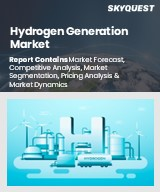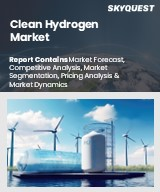
|
시장보고서
상품코드
1576677
블루 수소 시장 : 생성 프로세스별(수증기 메탄 개질, 자기열개질), 에너지원별(석탄, 메탄), 용도별(연료 공급, 원료), 최종사용자별(운송, 화학 생산), 지역별 - 세계 예측(-2030년)Blue Hydrogen Market by Generation Process (Steam Methane Reforming, Autothermal Reforming), Energy Source (Coal, Methane), Application (Fueling, Feedstock), End User (Transportation, Chemical Production), and Geography - Global Forecast to 2030 |
||||||
Meticulous Research(R) 조사 리포트 '블루 수소 시장 : 생성 프로세스별(수증기 메탄 개질, 자기열개질), 에너지원별(석탄, 메탄), 용도별(연료 공급, 원료), 최종사용자별(운송, 화학 생산), 지역별 - 세계 예측(-2031년)'은 주요 5 지역의 블루 수소 시장을 상세하게 분석하고, 현재 시장 동향, 시장 규모, 시장 점유율, 최근 동향, 2031년까지의 예측 등에 주목하고 있습니다.
블루 수소 시장은 2024-2031년 CAGR이 13.8%로, 2031년에는 335억 달러에 달할 것으로 예측됩니다.
블루 수소 시장의 성장은 화학 생산에서 블루 수소에 대한 수요 증가와 화학 생산의 탈탄소화를 위한 정부의 적극적인 노력에 의해 이루어지고 있습니다. 그러나 블루 수소 생산시 에너지 손실이 시장 성장을 저해하는 요인으로 작용하고 있습니다. 또한 블루 수소 생산 기술 개발은 시장 성장의 기회를 창출할 것으로 예상됩니다. 그러나 천연가스 네트워크에 블루 수소를 통합하는 것은 이 시장에서 활동하는 기업에게 큰 과제입니다. 또한 탄소 포집 및 활용 저장(CCUS) 기술의 채택이 증가하고 있는 것도 블루 수소 시장의 두드러진 추세입니다.
목차
제1장 서론
제2장 조사 방법
제3장 개요
- 시장 개요
- 시장 분석 : 생성 프로세스별
- 시장 분석 : 에너지원별
- 시장 분석 : 용도별
- 시장 분석 : 최종사용자별
- 지역별 시장 분석
- 경쟁 분석
제4장 시장 인사이트
- 개요
- 시장 성장에 영향을 미치는 요인
- 촉진요인
- 화학 생산에서 블루 수소의 수요 증가
- 화학 생산의 탈탄소화를 향한 정부 구상의 증가
- 억제요인
- 블루 수소 제조시 에너지 손실
- 기회
- 블루 수소 제조 기술의 발전
- 과제
- 블루 수소의 천연가스 네트워크에 대한 통합
- 촉진요인
- 시장 동향
- 탄소 포집·저장(CCUS) 기술의 채택 확대
- 사례 연구
- 사례 연구 A
- 사례 연구 B
- 사례 연구 C
제5장 블루 수소 시장 평가 : 생성 프로세스별
- 개요
- 수증기 메탄 개질
- 자기열개질
- 가스화
- 부분 산화
제6장 블루 수소 시장 평가 : 에너지원별
- 개요
- 석탄
- 메탄
- 수
제7장 블루 수소 시장 평가 : 용도별
- 개요
- 연료
- 원료
- 기타 용도
제8장 블루 수소 시장 평가 : 최종사용자별
- 개요
- 화학제품 제조
- 합성연료 제조
- 암모니아 제조
- 정유
- 메탄올 제조
- 제조업
- 발전
- 운송
- 기타 최종사용자
제9장 블루 수소 시장 평가 : 지역별
- 북미
- 미국
- 캐나다
- 유럽
- 독일
- 영국
- 프랑스
- 이탈리아
- 스페인
- 네덜란드
- 폴란드
- 기타 유럽
- 아시아태평양
- 일본
- 중국
- 인도
- 한국
- 싱가포르
- 기타 아시아태평양
- 라틴아메리카
- 중동 및 아프리카
제10장 경쟁 분석
- 개요
- 주요 성장 전략
- 경쟁 벤치마킹
- 경쟁 대시보드
- 업계 리더
- 시장 순위 : 주요 기업별
- 시장 차별화 요인
- 선행 기업
- 신규 기업
- 업계 리더
제11장 기업 개요(기업 개요, 재무 개요, 제품 포트폴리오, 전략적 개발)
- Matheson Tri-Gas, Inc.(U.S.)(A Subsidiary of Nippon Sanso Holdings Corporation)
- Shell plc(U.K.)
- Linde GmbH(Germany)
- L'AIR LIQUIDE S.A.(France)
- Air Products and Chemicals Inc.(U.S.)
- Uniper SE(Germany)
- ATCO Ltd.(Canada)
- Suncor Energy Inc.(Canada)
- Equinor ASA(Norway)
- Saudi Arabian Oil Company(Saudi Arabia)
- Aker Solutions ASA(Norway)
- Topsoe A/S(Denmark)
- Technip Energies N.V(France)
- Ivys Adsorption Inc.(U.S.)
- Woodside Energy Group Limited(Australia)
제12장 부록
KSA 24.11.25Blue Hydrogen Market by Generation Process (Steam Methane Reforming, Autothermal Reforming), Energy Source (Coal, Methane), Application (Fueling, Feedstock), End User (Transportation, Chemical Production), and Geography-Global Forecast to 2031
The research report titled 'Blue Hydrogen Market by Generation Process (Steam Methane Reforming, Autothermal Reforming), Energy Source (Coal, Methane), Application (Fueling, Feedstock), End User (Transportation, Chemical Production), and Geography-Global Forecast to 2031' from Meticulous Research(R) provides an in-depth analysis of the blue hydrogen market in five major geographies and focuses on the current market trends, market sizes, market shares, recent developments, and forecasts to 2031.
The blue hydrogen market is projected to reach $33.5 billion by 2031, at a CAGR of 13.8% from 2024 to 2031.
The growth of the blue hydrogen market is driven by the increasing demand for blue hydrogen in chemical production and increasing government initiatives to decarbonize chemical production. However, energy loss during blue hydrogen production is a factor restraining the growth of this market. Furthermore, the development of blue hydrogen production technologies is expected to generate market growth opportunities. However, the integration of blue hydrogen into natural gas networks is a major challenge for the players operating in this market. Additionally, the increasing adoption of carbon capture utilization and storage (CCUS) technology is a prominent trend in the blue hydrogen market.
The blue hydrogen market is segmented by generation process (steam methane reforming, autothermal reforming, gasification, and partial oxidation), energy source (coal, methane, and water), application (fueling, feedstock, and other applications), end user (chemical production, [synfuel production, ammonia production, petroleum refinery, and methanol production], transportation, power generation, manufacturing, and other end users), and geography. The study also evaluates industry competitors and analyzes the market at the regional and country levels.
Based on generation process, the blue hydrogen market is segmented into steam methane reforming, autothermal reforming, gasification, and partial oxidation. In 2024, the steam methane reforming segment is expected to account for the largest share of over 40.0% of the blue hydrogen market. The large market share of this segment is attributed to the increasing adoption of pure hydrogen in applications such as e-mobility, chemical production, and power generation, the growing availability of fossil fuels to produce blue hydrogen, and the rising use of steam methane reforming to reduce CO2 footprint.
However, the gasification segment is projected to register the highest CAGR during the forecast period due to the cost-effectiveness of the method in producing blue hydrogen, the increasing demand for low-carbon hydrogen as a fuel source for industrial applications, and the rising use of gasification to convert organic/carbon-based materials, including coal and biomass into blue hydrogen.
Based on energy source, the blue hydrogen market is segmented into coal, methane, and water. In 2024, the methane segment is expected to account for the largest share of the blue hydrogen market. The large market share of this segment is attributed to the growing availability of abundant feedstock for blue hydrogen production, the rising use of methane in steam methane reforming and autothermal reforming for blue hydrogen production, and the rising use of methane to produce blue hydrogen using CCS technology to capture and store carbon dioxide. Also, this segment is projected to register the highest CAGR during the forecast period.
Based on application, the blue hydrogen market is segmented into fueling, feedstock, and other applications. In 2024, the feedstock segment is expected to account for the largest share of over 35.0% of the blue hydrogen market. The large market share of this segment is attributed to the increasing adoption of blue hydrogen for chemical production and increasing government initiatives to promote the use of blue hydrogen due to its zero carbon footprint.
However, the fueling segment is projected to register the highest CAGR during the forecast period due to the increasing adoption of blue hydrogen for fueling due to its better energy efficiency compared to fossil fuels, increasing government initiatives to promote clean and flexible energy sources and support zero-carbon energy, and the increasing adoption of blue hydrogen for combustion due to its low smoke and lack of unpleasant fumes.
Based on end user, the blue hydrogen market is segmented into chemical production, transportation, power generation, manufacturing, and other end users. In 2024, the chemical production segment is expected to account for the largest share of over 55.0% of the blue hydrogen market. The large market share of this segment is attributed to the increasing adoption of blue hydrogen in chemical production due to its net-zero emissions, the growing use of blue hydrogen to sustainably produce methanol and ammonia, the increasing demand for highly efficient energy sources among refineries, and the increasing use of methanol as a clean energy resource.
However, the transportation segment is projected to register the highest CAGR during the forecast period due to the rising demand for blue hydrogen in the transportation sector to reduce carbon emissions, growth in blue hydrogen fueling solutions for a range of transportation and motive power applications, and the increasing adoption of blue hydrogen due to the need to lower carbon emissions, reduce dependence on oil, and reduce air pollution.
Based on geography, the blue hydrogen market is segmented into North America, Europe, Asia-Pacific, Latin America, and the Middle East & Africa. In 2024, Asia-Pacific is expected to account for the largest share of over 40.0% of the blue hydrogen market. The large market share of Asia-Pacific is attributed to the increasing adoption of clean energy solutions in sectors such as power generation and transportation, government investments and initiatives for blue hydrogen production to reduce emissions, funding programs and grants for clean fuel adoption, the focus on building large infrastructures for storing blue hydrogen, and strategic alliances and large-scale investments for creating a clean hydrogen economy. Also, APAC is projected to register the highest CAGR of over 15.0% during the forecast period.
The key players operating in the blue hydrogen market include Matheson Tri-Gas, Inc. (U.S.), Shell plc (U.K.), Linde GmbH (Germany), L'AIR LIQUIDE S.A. (France), Air Products and Chemicals Inc. (U.S.), Uniper SE (Germany), ATCO Ltd. (Canada), Suncor Energy Inc. (Canada), Equinor ASA (Norway), Saudi Arabian Oil Company (Saudi Arabia), Aker Solutions ASA (Norway), Topsoe A/S (Denmark), Technip Energies N.V (France), Ivys Adsorption Inc. (U.S.), and Woodside Energy Group Limited (Australia).
Key Questions Answered in the Report:
- Which are the high-growth market segments in terms of generation process, energy source, application, and end user?
- What is the historical market size for blue hydrogen globally?
- What are the market forecasts and estimates for 2024-2031?
- What are the major drivers, restraints, opportunities, challenges, and trends in the blue hydrogen market?
- Who are the major players in the blue hydrogen market, and what are their market shares?
- What is the competitive landscape like?
- What are the recent developments in the blue hydrogen market?
- What are the growth strategies adopted by major market players?
- What are the key market trends, and which are the high-growth countries?
- Who are the local emerging players in the blue hydrogen market, and how do they compete with the other players?
Scope of the Report:
Blue Hydrogen Market Assessment-by Generation Process
- Steam Methane Reforming
- Autothermal Reforming
- Gasification
- Partial Oxidation
Blue Hydrogen Market Assessment-by Energy Source
- Coal
- Methane
- Water
Blue Hydrogen Market Assessment-by Application
- Fueling
- Feedstock
- Other Applications
Blue Hydrogen Market Assessment-by End User
- Chemical Production
- Synfuel Production
- Ammonia Production
- Petroleum Refineries
- Methanol Production
- Manufacturing
- Power Generation
- Transportation
- Other End Users
Blue Hydrogen Market Assessment-by Geography
- North America
- U.S.
- Canada
- Europe
- Germany
- U.K.
- France
- Italy
- Spain
- Netherlands
- Poland
- Rest of Europe (RoE)
- Asia-Pacific (APAC)
- Japan
- China
- India
- South Korea
- Singapore
- Rest of Asia-Pacific (RoAPAC)
- Latin America
- Mexico
- Brazil
- Rest of Latin America (RoLATAM)
- Middle East & Africa
- Saudi Arabia
- UAE
- Israel
- Rest of Middle East & Africa (RoMEA)
TABLE OF CONTENTS
1. Introduction
- 1.1 Market Definition & Scope
- 1.2 Market Ecosystem
- 1.3 Currency & Limitations
2. Research Methodology
- 2.1 Research Approach
- 2.2 Process of Data Collection and Validation
- 2.2.1 Secondary Research
- 2.2.2 Primary Research/Interviews with Key Opinion Leaders of the Industry
- 2.3 Market Sizing and Forecast
- 2.3.1 Market Size Estimation Approach
- 2.3.2 Growth Forecast Approach
- 2.4 Assumptions for the Study
3. Executive Summary
- 3.1 Market Overview
- 3.2 Market Analysis, by Generation Process
- 3.3 Market Analysis, by Energy Source
- 3.4 Market Analysis, by Application
- 3.5 Market Analysis, by End User
- 3.6 Market Analysis, by Geography
- 3.7 Competitive Analysis
4. Market Insights
- 4.1. Overview
- 4.2 Factors Affecting Market Growth
- 4.2.1 Drivers
- 4.2.1.1 Increasing Demand for Blue Hydrogen in Chemical Production
- 4.2.1.2. Growing Government Initiative to Decarbonized Chemical Productions
- 4.2.2 Restraints
- 4.2.2.1 Energy Loss During the Blue Hydrogen Production
- 4.2.3 Opportunities
- 4.2.3.1 Growing Development of Blue Hydrogen Production Technologies
- 4.2.4 Challenges
- 4.2.4.1 Integration of Blue Hydrogen into Natural Gas Networks
- 4.2.1 Drivers
- 4.3 Market Trend
- 4.3.1 Increasing Adoption of Carbon Capture Utilization and Storage (CCUS) Technology
- 4.4 Case Studies
- 4.4.1 Case Study A
- 4.4.2 Case Study B
- 4.4.3 Case Study C
5. Blue Hydrogen Market Assessment, by Generation Process
- 5.1 Overview
- 5.2 Steam Methane Reforming
- 5.3 Autothermal Reforming
- 5.4 Gasification
- 5.5 Partial Oxidation
6. Blue Hydrogen Market Assessment, by Energy Source
- 6.1 Overview
- 6.2 Coal
- 6.3 Methane
- 6.4 Water
7. Blue Hydrogen Market Assessment, by Application
- 7.1 Overview
- 7.2 Fueling
- 7.3 Feedstock
- 7.4 Other Applications
8. Blue Hydrogen Market Assessment, by End User
- 8.1 Overview
- 8.2 Chemical Production
- 8.2.1 Synfuel Production
- 8.2.2 Ammonia Production
- 8.2.3 Petroleum Refinery
- 8.2.4 Methanol Production
- 8.3 Manufacturing
- 8.4 Power Generation
- 8.5 Transportation
- 8.6 Other End Users
9. Blue Hydrogen Market Assessment, by Geography
- 9.1 North America
- 9.1.1 U.S.
- 9.1.2 Canada
- 9.2 Europe
- 9.2.1 Germany
- 9.2.2 U.K.
- 9.2.3 France
- 9.2.4 Italy
- 9.2.5 Spain
- 9.2.6 Netherlands
- 9.2.7 Poland
- 9.2.8 Rest of Europe
- 9.3 Asia-Pacific
- 9.3.1 Japan
- 9.3.2 China
- 9.3.3 India
- 9.3.4 South Korea
- 9.3.5 Singapore
- 9.3.6 Rest of Asia-Pacific
- 9.4 Latin America
- 9.5 Middle East & Africa
10. Competition Analysis
- 10.1 Overview
- 10.2 Key Growth Strategies
- 10.3 Competitive Benchmarking
- 10.4 Competitive Dashboard
- 10.4.1 Industry Leader
- 10.4.1.1 Market Ranking, By Key Player
- 10.4.2 Market Differentiators
- 10.4.3 Vanguards
- 10.4.4 Emerging Companies
- 10.4.1 Industry Leader
11. Company Profiles (Company Overview, Financial Overview, Product Portfolio, and Strategic Development)
- 11.1 Matheson Tri-Gas, Inc. (U.S.) (A Subsidiary of Nippon Sanso Holdings Corporation)
- 11.2 Shell plc (U.K.)
- 11.3 Linde GmbH (Germany)
- 11.4 L'AIR LIQUIDE S.A. (France)
- 11.5 Air Products and Chemicals Inc. (U.S.)
- 11.6 Uniper SE (Germany)
- 11.7 ATCO Ltd. (Canada)
- 11.8 Suncor Energy Inc. (Canada)
- 11.9 Equinor ASA (Norway)
- 11.10 Saudi Arabian Oil Company (Saudi Arabia)
- 11.11 Aker Solutions ASA (Norway)
- 11.12 Topsoe A/S (Denmark)
- 11.13 Technip Energies N.V (France)
- 11.14 Ivys Adsorption Inc. (U.S.)
- 11.15 Woodside Energy Group Limited (Australia)
12. Appendix
- 12.1. Available Customization
- 12.2. Related Reports



















